
| Car: | Ford | Fiesta | CX (Mk3) | XR2i | Hatchback |
| Engine: | BUB | 3189 | V6 | (15º V6) | N/A | Petrol |
1.8 16v Zetec-E Turbo conversion
Breather system
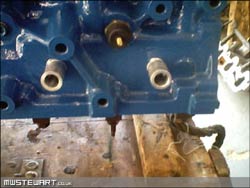
Inside every engine there is a slight crankcase pressure which is caused by small amounts of gas bypassing the piston rings. The level of bypass in turbocharged applications is elevated as boost rises. As the Zetec was designed as a naturally aspirated engine the breather system would soon become clogged when even modest amounts of boost were run so I have had two additional take offs installed in the block. Its best to have two as oil surge could block one up, with nasty results.
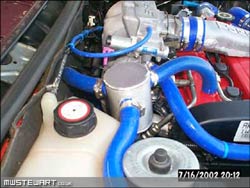
It is optional to have an additional oil breather from the cam cover, there are arguments for and against this however as some professional race teams are against breathing from the head as the higher pressure in the crankcase can rush to vent from the head, restricting the oil return.
I have opted for an additional cam vent as well as a baffled oil separator
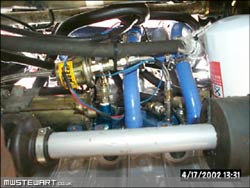
Here is the breather system as viewed from underneath the car, you can also see the take off for the turbo oil feed, oil pressure gauge sender, oil temp sender. I have also retained the standard Ford oil pressure sender as its a handy indicator of a slightly low oil level.
NOTE: I have installed various gauges in the car so I can keep an eye on the engines operation, I've listed the modifications made in the INTERIOR section.
Charge temperature control
Please see Charge temperature control for details.
Compression ratio
The standard Zetec-E engine isn't particularly suited to turbo charging, as it runs a compression ratio of 10:1. US Federal Zetec engines run 9:1 compression to prevent detonation from poor pump fuel, but even that sort of C/R is only suited to a very low pressure setup - sub 7psi, which wouldn't make the conversion worthwhile.
The way to go about lowering the standard compression is to change the pistons to dished, forged items. Both Mahle and Arias make suitable pistons, but its worth noting that there's a lot more choice for the 1800 engine (including standard pistons from other turbocharged cars). This method involves an engine strip down and rebuild but will result in a much stronger/reliable engine.
Cooling
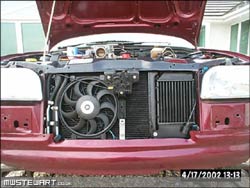
I am using a standard FRST radiator. The turbo I've chosen is oil cooled only as I didn't want too much heat transferring to the engines cooling system - this will be working hard anyway. I've used a slim line Kenlowe fan which enables me to keep the standard bumper.
I'm using a standard Fiesta RS intercooler which will be mounted next to the radiator, I have moved the cars battery to the boot which has given me enough room to mount an additional charge cooler.
I had to move the PAS oil cooler from its original position to deep in the front valance. There are large air vents in the bottom of the valance so airflow will still be adequate.
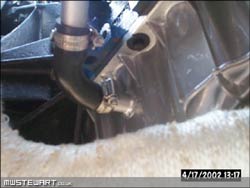
The turbo itself needs oil feed and return, for the feed I've used a T piece in-between the oil pressure sender and block. For the return I've welded an aluminium fitting into the sump, onto which a 90 degree connector will screw joining to the turbo with braided oil hose. The position of the oil return is important, it should be as low as possible to help the turbo drain easily, but must be above the oil level in the sump or a restriction will occur.

I had installed an oil cooler on the car when I completed the first 2 litre conversion a couple of years ago. Unfortunately there isn't room at the front of the radiator this time around so I've made some custom brackets and mounted it in the wheel arch - in front of the O/S wheel behind the plastic arch liner.
New oil lines were made up to suit to the new location.
Here it is as viewed from underneath the car
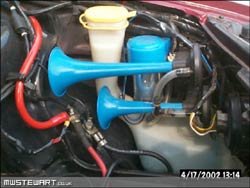
As I moved the battery to the boot of the car to gain more room I decided to also move the air horns. My Dad made me a bracket that mounts them along with the compressor on the N/S inner wing, it looks neat.
The battery take off points can be seen in this picture.
I am running a Kenlowe 10" blow fan at the front of my radiator. Of all the fans this was the slimmest design available enabling me to keep the front bumper standard. I also like the brand as they have been making car fans for years.
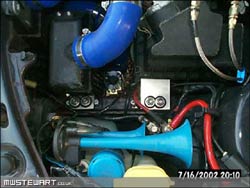
The unit is controlled by a variable electronic thermostat, which uses a sensor bulb installed in the radiator top hose. I have bypassed the standard ford fan switch by soldering the two wires together, which gives full control to the Kenlowe thermostat. I can now set the exact point at which the fan will cut in.
Drive train
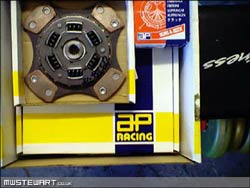
The clutch from a standard RST can withstand 200BHP, but I'm not sure how much above that it would endure. I have chosen to fit an AP uprated clutch. The Zetec clutches are mostly low lift so pedal pressure wont be increased that much. Its worth noting that the gearboxes can withstand quite a reasonable amount of torque but wont last 5 minutes if driven hard in the lower gears.
Its also well worth investing in some larger brakes, but at the end of the day you drive within yours the cars limitations!
Engine management
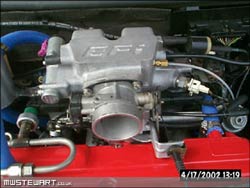
The most cost effective way of managing a full 16vT is to use Fiesta RS Turbo EECIV. There were three types of this - OFAA, OFAB and OFAC, I have chosen OFAB as it is compatible with 3 bar MAP sensors which will enable me to run higher boost should I wish to. The ECU must be matched with the corresponding sensors so its best to get everything from one car, I got the whole lot from a scrap yard for a reasonable price.
The engine management loom on all Fiestas is separate from the car loom, its joined by a 7 pin multiplug on the bulkhead. This was great as it saved me having to remove the dashboard etc to fit another loom! (which means I still have PATS/airbags etc)
Once everything is fitted a chip is required to ensure correct fuelling, boost limit removal and altered ignition curve.
Exhaust
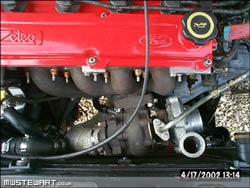
My mate Dave did a fantastic job of fabricating me an exhaust, including a flexible section and custom front mount. I lagged the downpipe to keep under-bonnet temperatures down. Here is the turbo on the manifold, the custom downpipe can be seen also.
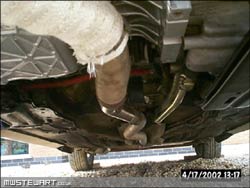
On the turbo itself I am using a Saab exhaust housing and exhaust downpipe. The turbo is mated to an Escort Turbo manifold, this item flows well up to around 280-300BHP.
Fuel system
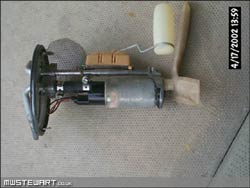
Suitable injectors are selected based upon engine spec and calculated flow rates. I have gone for a reasonable amount of power and such a spec that my standard fuel pump will no longer be sufficient.
The pump and sender unit are combined and fit into the top of the fuel tank, with a little patience the standard pump can be removed and swapped for another one.
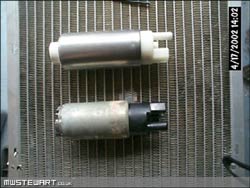
The pump I have gone for is a group A Escort Cosworth item. This is also an in tank pump and will fit within the standard Fiesta pump cradle.
My pump came with a fitting kit which includes thicker power supply cable, new rubber fuel hose and a new strainer. To fit the pump in the standard Fiesta cradle I had to open out the hole at the bottom of the sender unit as the new pumps suction inlet was considerably larger!
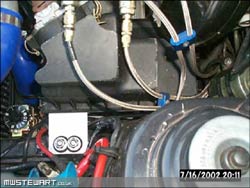
I have never been a fan of the conical type filters that are claimed to release a couple of extra horses from an engine. I'm not a fan of the induction roar they produce for a start and on my previous install with a hotwire MAF they induce rough running, especially affecting low RPM tractability. Noise won't be a problem on a turbocharged engine as the compressor blades act as a silencer for engine roar anyway, but the main reason I dislike conical filters is heat-soak. In the small Fiesta engine bay temperatures are high, and the filter sits right in amongst all the heat which has the effect of raising charge temps - affecting performance.
To get around this problem I used a Ford airbox. I heavily modified it to fit in the, somewhat limited, space I had underneath the brake master cylinder. The airbox is mounted using the same bracket system as the second intercooler.
Head
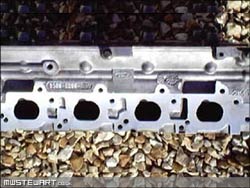
To mount the turbo I used an Escort RS Turbo manifold, but there is a little more work involved to crate a decent seal. Various areas of the head have to be built up with weld, and the whole port faces re-faced then new holes drilled and tapped. The top N/S studs will breach oil ways so ensure the engine is thoroughly washed out and the stud is refitted with chemical metal. Alternatively this stud can be left out.
To finish the head is ported and the port shapes altered to suit the escort manifold.
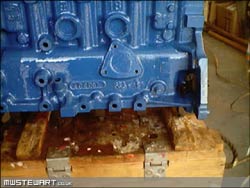
Unfortunately the Escort manifold fouls the front Zetec breather, so this has to be blocked up.
Turbo

The turbocharger I have gone for is a Garrett T03 with internal wastegate, it suits the Zetec's high rev band perfectly. There are many different components that can be added together to create a T3 - different compressor wheels, covers, exhaust housings, exhaust turbine covers and exhaust wheels.
The standard route for Ford modifying is to use a standard Escort turbo T03 - It uses a very small compressor wheel and exhaust wheel cover - I've decided to go for a T3 with large compressor wheel and exhaust wheel cover to suit the relatively high flow of my engine compared to a standard 1.6 Escort.
If you're not researching the turbo conversion yourself then phone Ian Howell (01522) 877887. Give him a call for a price on a Zetec turbo, engine rebuild or whatever you want doing
© Mark Stewart, Friday 15th March 2002
![[XML RSS Feed]](/images/xml/xml_rss.jpg)